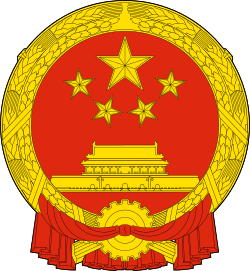Scientific Outlook on Development
 |
| This article is part of a series on the politics and government of China |
|
|
The Scientific Outlook on Development, (simplified Chinese: 科学发展观; traditional Chinese: 科學發展觀; pinyin: Kēxué Fāzhǎn Guān) sometimes translated to either the scientific development concept,[1] or as the scientific development perspective, is one of the guiding socio-economic principles of the Communist Party of China (CPC) and the central feature of former Party General Secretary Hu Jintao's attempts create a "harmonious society."
The SOD incorporates scientific socialism, sustainable development, social welfare, a humanistic society, increased democracy, and, ultimately, the creation of a Socialist Harmonious Society. According to official statements by the CPC, the concept integrates "Marxism with the reality of contemporary China and with the underlying features of our times, and it fully embodies the Marxist worldview on and methodology for development."[2]
The two key themes of the SOD are that "the people are the basis" and that China's development must be "comprehensive."
The ideology is recognized by observers as a comprehensive response to the ideological gap left by the social problems that resulted from China's market economic reforms. Credit for the theory is given to former Chinese leader Hu Jintao and his administration, who was in power from 2002 to 2012. It is the newest slogan added to the idea of Socialism with Chinese characteristics ratified into the Communist Party of China's constitution at the 17th Party Congress in October 2007. It is lauded by the Chinese government as a successor and extension ideology to Marxism-Leninism, Mao Zedong Thought, Deng Xiaoping Theory and the Three Represents.
Background
Before Jiang Zemin left his office of General Secretary of the Communist Party of China, the ideological contribution of the "third generation of leadership" was entrenched in the party and state constitutions in 2000 under the name Three Represents.
Hu Jintao, had as one of his main goals in his early administration to fill the ideological vacuum left by China's leadership since Deng's economic growth-oriented policies opened a conceptual gap with orthodox Marxism-Leninism. While creating a new "middle class" as well as upper layers, the sheer size of the population and the starting conditions have necessarily meant that the bulk of the population has remained closer to those original conditions, a situation considered undesirable and unstable by the national leadership (whence the Socialist Harmonious Society policy). The idea was to thrash out an approach to the country’s increasingly serious social problems and the generally held belief in the untenability of continuously rising inequality. In addition, the unstated focus on GDP growth by local governments was beginning to detract from overall societal development, also leading to false figures and various infrastructure projects aimed solely at growing the monetary measure of output. The conclusion was the need for a new ideological campaign to shift the focus of the official agenda from "economic growth" to "social harmony". The idea, although not in the exact terms by which it would later become known, was first embraced by the Third Plenary Session of the 16th Central Committee, which convened in Beijing on October 11 to 14, 2003.[3] Guangdong Party Secretary Zhang Dejiang openly embraced the idea at a provincial party session in Guangdong.
General secretary Hu Jintao subsequently launched the campaign in full form with a speech to the National People's Congress calling for the building of "a Socialist Harmonious Society". He summed up his conception as the development of "democracy, the rule of law, justice, sincerity, amity and vitality" as well as a better relationship between the people and the government and "between man and nature", meaning environmental harmony.
Comparison with other ideologies
It is also likely that the idea was also an attempt at solidifying Hu Jintao's status of a paramount position in China, as all other leaders before him had an ideology associated with them, namely, Mao Zedong Thought, Deng Xiaoping Theory, and Jiang's Three Represents. However, the fact that the concept was implemented during Hu's time in office, whereas all other ideologies were implemented after each leader's respective term had ended, seems to point that Hu wanted to assert his political stature rather urgently primarily to drown out growing dissent of Three Represents and signify Jiang's dwindling position of power.
The SOD reflected a departure from Jiang Zemin's Three Represents in that it laid emphasis on correcting the unbalanced growth that had been much more favorable to wealthier, coastal provinces, neglecting the Chinese inland. It also put more emphasis on the masses rather than the elites, according to David Shambaugh.[4]
The ideology also states to be much more democratic and rights-based in its tone. Whereas Maoism was political in nature, Dengism and Jiangism were economic, Scientific Development is social in its focus . The concept reflects a trend within the Communist Party of China under the Hu-Wen Administration to subscribe to more populist policies and guidelines.
By around 2005 Hu Jintao was using the SOD concept as a catch-all for a wide variety of policies that had no other unifying theme. These included: improving tural areas, speeding up economic growth, using resources efficiently, and more.[4]
See also
References
- ↑ simplified Chinese: 科学发展观; traditional Chinese: 科學發展觀; pinyin: Kēxué Fāzhǎn Guān.
- ↑ "Full text of Hu Jintao's report at 18th Party Congress". People's Daily. November 19, 2012. Retrieved 19 September 2014.
- ↑ Promoting the Scientific Development Concept: Joseph Fewsmith
- 1 2 Shambaugh, David L. (2008-01-01). China's Communist Party: Atrophy and Adaptation. University of California Press. ISBN 9780520254923.
